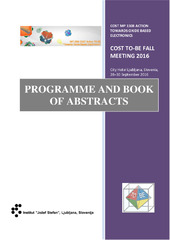Приказ основних података о документу
Microstructure and functional properties of Sr-doped K0.5Na0.5NbO3 thin films
| dc.creator | Vojisavljević, Katarina | |
| dc.creator | Pečnik, Tanja | |
| dc.creator | Uršič, Hana | |
| dc.creator | Matavž, Aleksander | |
| dc.creator | Bobnar, Vid | |
| dc.creator | Malič, Barbara | |
| dc.date.accessioned | 2023-12-08T18:36:26Z | |
| dc.date.available | 2023-12-08T18:36:26Z | |
| dc.date.issued | 2016 | |
| dc.identifier.isbn | 978-961-264-096-5 | |
| dc.identifier.uri | http://rimsi.imsi.bg.ac.rs/handle/123456789/2894 | |
| dc.description.abstract | The legislation against the use of lead-based piezoelectric materials in electronics has stimulated an increased research in the field of the lead-free piezoelectric ceramics and thin films after 2003. Among lead-free materials, special attention was paid to some compositions of potassium sodium niobate solid solution, K0.5Na0.5NbO3 (KNN) obtained by a partial replacement of A- and B- site atoms from the perovskite KNN crystal lattice with dopants. Excellent piezoelectric and ferroelectric properties of chemically modified KNN ceramics indicate that they can be used as the efficient lead-free counterparts to lead-based piezoelectrics. Although A-site doping of KNN ceramics with low amounts of alkaline earths (Ca2+, Sr2+, Ba2+), particularly with Sr2+ was reported as an useful way in improvement of their density and electrical properties [1, 2], there is no literature data concerning the microstructure and functional properties of KNN thin films influenced by the same chemical modification. In this contribution, liquid precursors of (K0.5Na0.5)1-ySryNbO3 (KNN-ySr) thin-films, where the Sr- dopant content was set at y = 0, 0.005, 0.01, were prepared from potassium and sodium acetates and niobium ethoxide in 2-methoxyethanol solvent with 5 mole % of potassium acetate excess, and an appropriate amount of strontium acetate dissolved in acetic acid. The approximately 250 nm thick KNN-ySr thin films on Pt/TiOx/SiO2/Si substrates were obtained through repeated spin-coating and pyrolysis steps at 300 oC for 2 min, followed by the rapid thermal annealing at 650 oC in air flow for 5 min with a heating rate of 12 K/s. According to X-ray diffraction analysis, all of the synthesized KNN thin films crystallize in pure perovskite phase with (100) preferential orientation. The surface and cross-section microstructure analysis, performed by the field emission scanning electron microscopy, reveals that the KNN-ySr films consist of equiaxed grains, the average size of which gradually decreases from about 90 nm to a few tens of nm by increasing the Sr-dopant content. Dielectric properties versus frequency, polarisation – electric field dependence and leakage current were followed in order to get information on how the Sr-dopant content influences the functional properties of the as-prepared films. In addition, the topography and the local piezoelectric response of the KNN-ySr films were analysed by atomic force microscopy coupled with a PFM mode. References: [1] B. Malič, J. Bernard, J. Holc, D. Jenko, M. Kosec, Alkaline-earth doping in (K,Na)NbO3 based piezoceramics, J. Eur. Ceram. Soc. 25 (2005) 2707-2711. [2] M. Demartin Maeder, D. Damjanović, N. Setter, Lead free piezoelectric materials, J. Electroceram. 13 (2004) 385-392. | sr |
| dc.language.iso | en | sr |
| dc.publisher | Ljubljana, Slovenia/Jožef Stefan Institute | sr |
| dc.rights | openAccess | sr |
| dc.source | COST TO-BE. Fall Meeting | sr |
| dc.subject | (K0.5Na0.5)1-ySryNbO3 | sr |
| dc.subject | sol-gel synthesis | sr |
| dc.subject | thin films | sr |
| dc.subject | FE-SEM | sr |
| dc.subject | PFM | sr |
| dc.title | Microstructure and functional properties of Sr-doped K0.5Na0.5NbO3 thin films | sr |
| dc.type | conferenceObject | sr |
| dc.rights.license | ARR | sr |
| dc.citation.epage | 89 | |
| dc.citation.spage | 89 | |
| dc.identifier.fulltext | http://rimsi.imsi.bg.ac.rs/bitstream/id/7611/bitstream_7611.pdf | |
| dc.identifier.rcub | https://hdl.handle.net/21.15107/rcub_rimsi_2894 | |
| dc.type.version | publishedVersion | sr |

